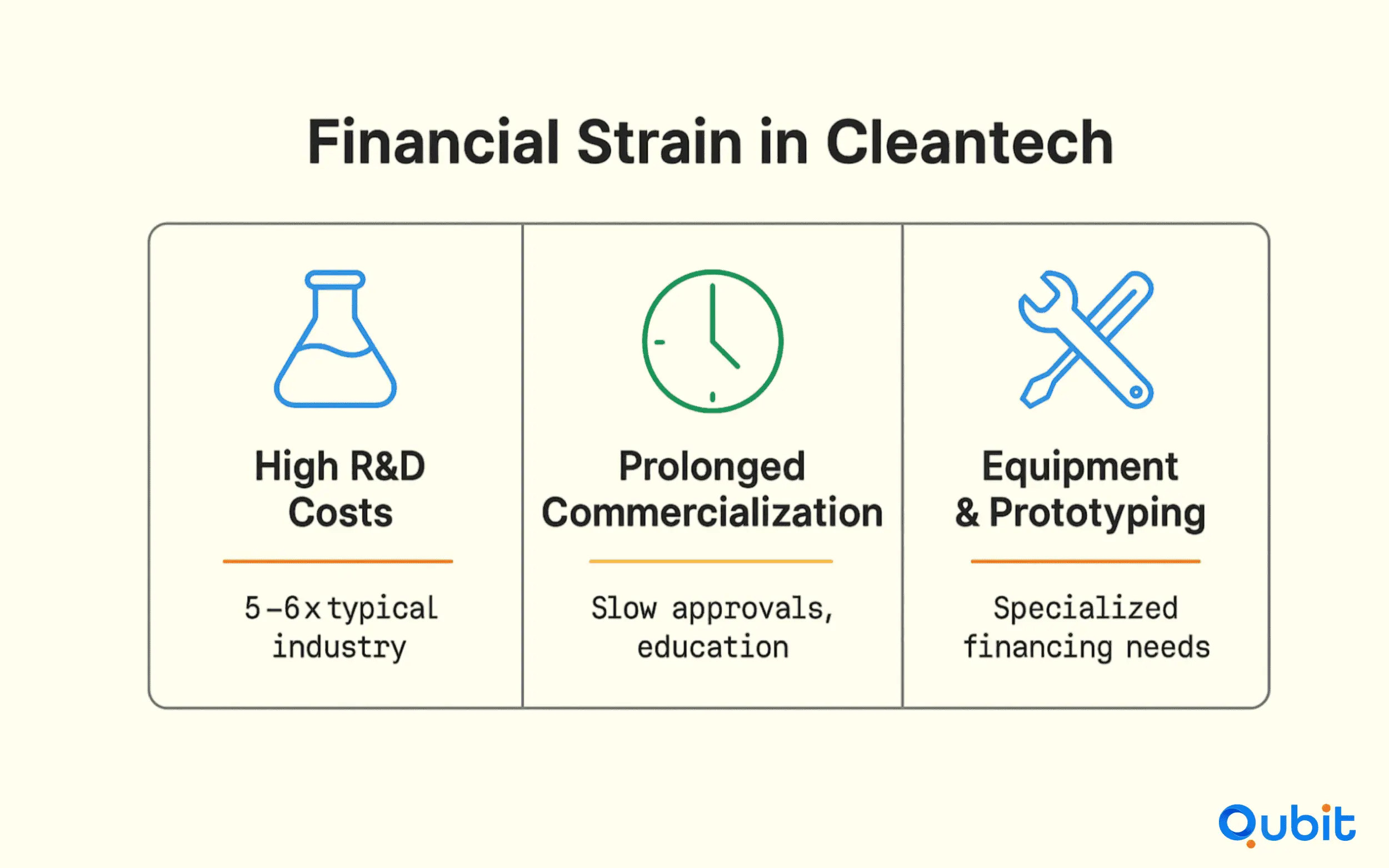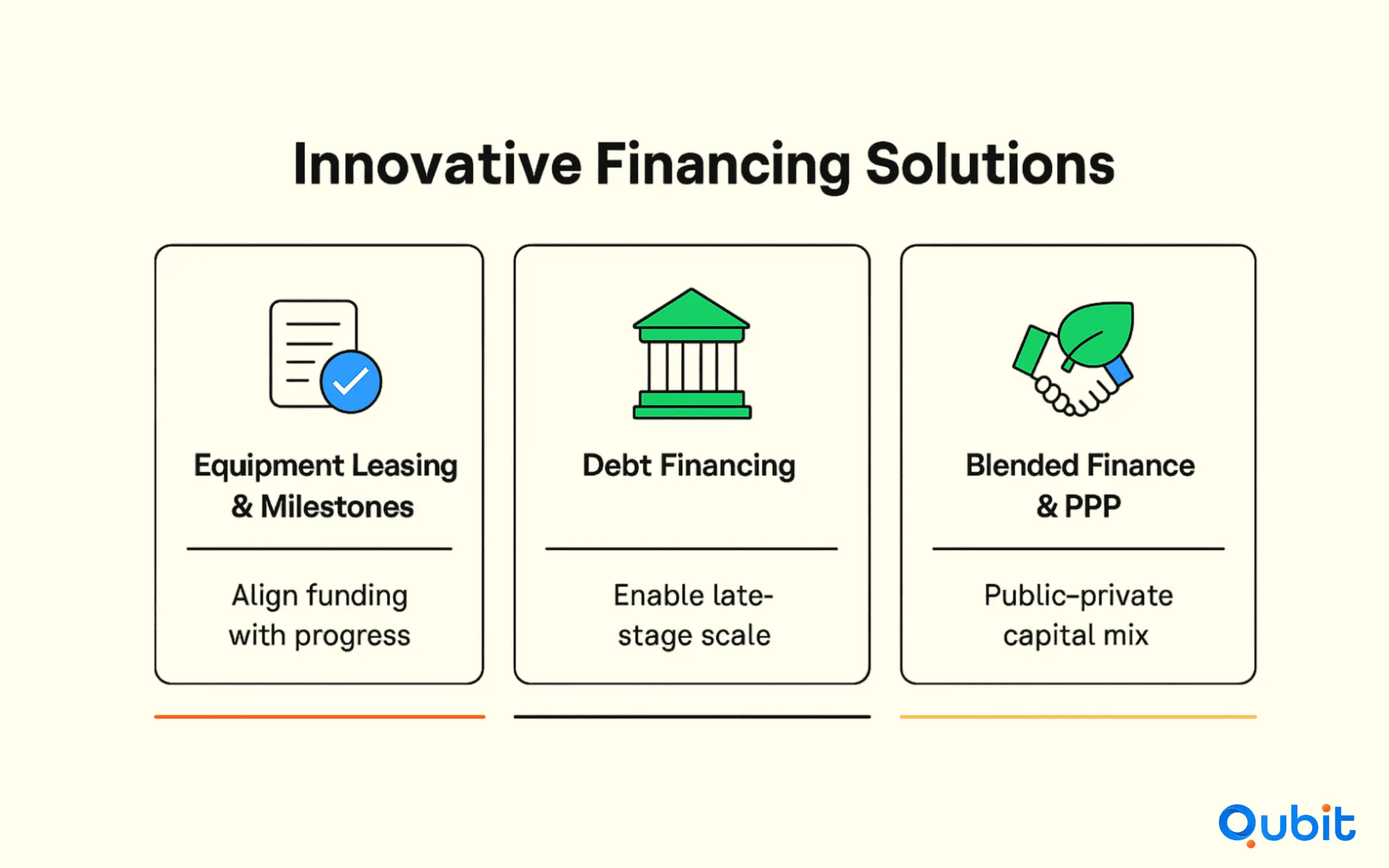The cleantech sector is renowned for its transformative potential, yet it faces unique hurdles, particularly in securing funding for capital-intensive projects. Early-stage ventures often grapple with high upfront costs, extended development timelines, and uncertain returns, making traditional funding routes less accessible. These challenges demand innovative approaches to financing that align with the sector's sustainability goals.
Your examination of cleantech startup fundraising strategies reveals a broad framework of funding dynamics, placing you within the context of both challenges and opportunities in the cleantech sector. This perspective connects foundational concepts with the overall funding landscape for capital-intensive projects.
This blog explores why cleantech funding is inherently demanding, highlights key obstacles, and offers actionable solutions to help startups secure large-scale financing.
Why Cleantech Funding Is Inherently Demanding
Cleantech investments have long been a double-edged sword for venture capitalists. While the promise of sustainable technologies is undeniable, the path to profitability is fraught with challenges. Historical data reveals that early cleantech ventures suffered capital losses exceeding 50%, leaving many investors wary and influencing funding decisions today.
The Financial Strain of Cleantech Development
Cleantech startups face financial hurdles that set them apart from other sectors like software or consumer goods:

- High R&D Costs: Research and development for climate technologies are often five to six times higher than in other industries. Specialized equipment, rigorous testing, and long development cycles drive up expenses.
- Prolonged Commercialization: Unlike software, cleantech solutions must navigate regulatory approvals, infrastructure compatibility, and consumer education, all of which delay returns and increase risk.
- Equipment & Prototyping: Many startups, such as those in HVAC or energy storage, turn to equipment financing to offset high prototype costs.
Expertise and Risk Assessment
Investing in cleantech requires deep scientific and technical expertise. Without thorough understanding of technological risks, investors may struggle to differentiate between viable innovations and overhyped concepts. This makes technical due diligence and sector specialization critical for mitigating investment risks.
Funding Constraints and Market Dynamics
The sector is also grappling with a contraction in venture funding. In 2025, global climate-tech venture capital is projected to decline by over 25%. This has led to longer fundraising rounds and forced startups to explore alternative financing solutions. While some success stories exist, such as large Series A raises for breakthrough technologies, these remain exceptions.
The Evolving Investor Landscape in Cleantech
The cleantech investment landscape is no longer dominated solely by traditional venture capitalists. Today, a diverse mix of institutional investors, family offices, sovereign wealth funds, and corporate venture arms are actively seeking exposure to sustainable technologies. This diversification brings more capital and expertise to the table, but it also raises the bar for startups in terms of technical validation, scalability, and impact measurement.
Family offices and sovereign wealth funds are increasingly allocating capital to climate solutions, often with a longer time horizon and a greater appetite for infrastructure-scale projects. Meanwhile, corporate venture capital (CVC) arms, especially those from energy, automotive, and chemicals sectors, are not just investing, but also offering strategic partnerships, pilot opportunities, and access to global supply chains.
Government Incentives and Support
Government incentives, such as tax credits and grants, play a pivotal role in bridging funding gaps. These programs reduce operational costs and provide stability during critical growth phases, helping startups survive the capital-intensive “valley of death” between pilot and commercial scale.
Innovative Financing Solutions
To overcome these challenges, the cleantech sector is embracing new models:

- Equipment Leasing & Milestone-Based Funding: These approaches align investment with technical progress, reducing risk for investors and supporting long-term growth.
- Debt Financing: Debt rounds are increasingly used for late-stage projects, especially in renewable energy, enabling grid-level solutions and project scalability.
- Blended Finance & Public-Private Partnerships: Combining public and private capital helps de-risk early-stage projects and attract institutional investors.
- ESG-Driven Capital: Environmental, Social, and Governance (ESG) criteria are now a central driver of sustainable capital allocation, with investors prioritizing projects that align with global sustainability goals.
Corporate Partnerships: A Strategic Avenue
Corporate partnerships are bridging late-stage funding gaps. Collaborations between startups and established companies provide access to resources, expertise, and market channels, facilitating the commercialization of innovative technologies. Strategic alliances are increasingly recognized as essential for scaling demonstration projects and bringing promising solutions to market.
The Scale of Global Clean Energy Investments
While global clean energy investments now exceed $300 billion annually, this still falls short of the $2.4 trillion needed each year to meet climate targets. Achieving this scale will require even greater collaboration between public and private stakeholders, as well as continued innovation in financing models.
The Importance of Policy and Regulatory Stability
Policy frameworks and regulatory signals play an outsized role in cleantech funding. Investors closely monitor government incentives, carbon pricing, and renewable portfolio standards to assess the long-term viability of projects. Sudden changes in policy—such as the rollback of tax credits or tariffs on imported components—can disrupt markets and stall project pipelines.
In 2025, regions with stable, forward-looking policies continue to attract the lion’s share of global clean energy investment. The U.S. Inflation Reduction Act, the EU Green Deal, and China’s Five-Year Plans are all cited as major drivers of investor confidence.
Technology Readiness and Bankability
A key challenge for capital-intensive cleantech is moving from technical proof-of-concept to “bankable” projects that meet the due diligence standards of commercial lenders and institutional investors. This requires:
- Independent performance validation (third-party testing, pilot results)
- Standardized contracts and offtake agreements
- Clear pathways to permitting and regulatory compliance
Startups that can demonstrate these factors are more likely to secure project finance and scale successfully.
Actionable Solutions for Startups
- Align with ESG Goals: Highlight your startup’s environmental impact and alignment with sustainability frameworks to attract ESG-focused investors.
- Demonstrate Technical and Market Validation: Secure pilot customers, offtake agreements, or strategic partnerships to prove commercial viability.
- Leverage Government Programs: Apply for grants, tax credits, and public funding to de-risk early stages.
- Pursue Corporate Partnerships: Seek collaborations with established industry players to gain credibility and access to new markets.
- Embrace Innovative Financing: Consider equipment leasing, milestone-based funding, and debt as alternatives to traditional venture capital.
Conclusion
Securing funding for cleantech initiatives requires a thoughtful balance between historical lessons and innovative approaches. Throughout this blog, we’ve explored strategic insights and addressed key challenges that startups face in this dynamic sector. By understanding past funding trends and embracing data-driven strategies, entrepreneurs can craft compelling narratives that resonate with investors.
The importance of aligning your funding strategy with both market demands and sustainability goals cannot be overstated. Combining analytical rigor with storytelling ensures that your pitch not only informs but inspires.
At Qubit Capital, we specialize in helping startups secure the funding they need to thrive. If you're ready to elevate your approach, explore our Fundraising Assistance service. Let us help you turn your vision into reality.
Key Takeaways
- Cleantech funding is highly capital-intensive with historical losses influencing investor caution.
- High R&D expenses, long scaling timelines, and market barriers remain significant challenges.
- Government incentives and ESG mandates are beginning to reshape the funding landscape.
- Alternative financing methods, such as lease financing and corporate partnerships, offer viable solutions.
- Technical due diligence is essential to mitigate risk and secure successful capital commitments.
Frequently asked Questions
What are the main funding challenges for cleantech startups?
Cleantech startups often encounter significant hurdles due to high research and development (R&D) expenses, extended timelines for product development, and uncertainties in political and regulatory frameworks. Additionally, market adoption can be slow, making it difficult for these capital-intensive businesses to secure early-stage investments.


 Back
Back



